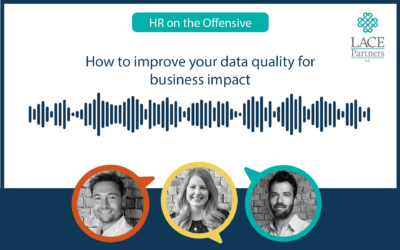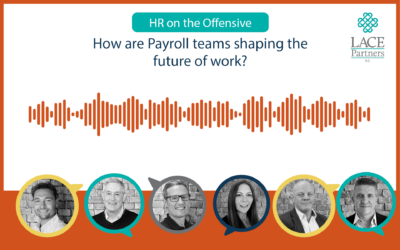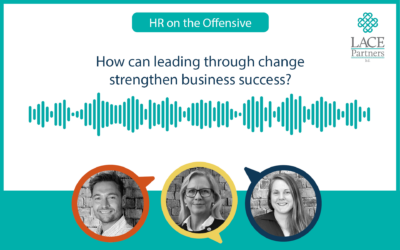This blog summarises the key points from our recent webinar which focused on the ways in which organisations can best prepare themselves for their move to the Cloud. Max Bailey, Aaron Alburey, from LACE Partners, were joined by Jo Munday (UK Head of People Operations, Investec) and Matt Jolley (Global Director of HRIS, AVEVA) to discuss how changes in industry caused by the pandemic have increased demand for an improved employee and colleague experience, underpinned by more agile and responsive people systems. Max gives us a summary of some of the key talking points.
What has motivated businesses to move to the Cloud and to what extent has COVID been a contributing factor?
Businesses in periods of accelerated growth and change need software which is flexible and can respond and scale to their changing needs. ‘On-premise’ solutions can’t always keep up. The tools needed for each business and HR service can differ in their maturity and capability, alongside the team’s capability to deliver services to the employee. Moving to cloud is part of the answer but not the whole answer.
Clearly the pandemic has emphasised the need for an improved employee/colleague experience and Cloud capability is one aspect of improving experience. What the global pandemic did was to underline to many teams that their current systems were insufficient to cope with the increased demands for data, reporting and functionality.
Many businesses were already thinking about their journey to the Cloud, but the pandemic has given us the push to realise the power of people systems in helping businesses respond and cope with business challenges.
(If you’d like to read more about how you can become more adaptable when it comes to using your data, you can also read our recent blog on it here).
What benefits can the business expect following their move to the Cloud?
Employee experience
Intuitive tools can give employees a refreshed and improved experience which, in turn, can boost productivity and connectivity between different parts of the organisation. This is not just better self-service on a laptop or workstation, but also a vastly improved mobile experience, with additional channels such as ‘live chat’ or even voice. Think “Alexa, book next Thursday off” as an example. When this is combined with wraparound Cloud service enablement technology such as case management you can see the power of an integrated the employee experience across multiple channels, providing a single view of the employee.
Cost benefits
In the longer term the businesses can expect to see a financial gain, however, in the short-term cost savings in one area may be offset by additional costs in implementation, software, and support. For HR teams there is a real emphasis on demonstrating the value of the new tools and digital services to the wider business as quickly. Having a baseline in your business case to measure change against which proves the value of your transformation based on clear and reliable data is powerful.
People empowerment and self-sufficiency
The vastly improved employee and colleague experience provided by Cloud technology allows employees and line managers to access people services, across multiple digital channels, at point of need. This frees up HR teams to focus on less administrative tasks and allowing them the time to be “high touch” for the interactions which matter most in the employee lifecycle.
Easier and more consistent compliance reporting
A Cloud transformation, based on an integrated set of systems and data, provides a vastly improved single view of the employee. This means easier compliance to data legislation and easier compliance reporting based on your industry and workforce compliance needs. From the Senior Manager Compliance Regime (SMCR) to confirmation of certifications and licences in a regulated workforce, transforming and integrating your systems, processes and data will make compliance easier.
What are the things should you be prioritising in your design?
Cloud technology has a powerful role to play in reducing repetitive manual tasks and administration through automation. Focusing on where you can standardise, harmonise, and automate currently manual tasks, alongside improving the end-to-end people experience of your processes will drive the biggest impact from your investment. This will not only improve consistency and quality in your data but will also give your employees and HR more time to focus on the more important aspects of their roles, rather than processing data through inconsistent processes and systems.
It’s important to establish broad user forums at the beginning of the design process to not only improve the overall design, but to also avoid the sentiment later it was just one group who have designed the system. This means involving multiple countries and offices, line managers and employees in the design process in addition to the HR “product owners”. This is a meaningful way to get insight into how others in the business are using the existing tech and to ensure that the current functionality is maintained and improved on through your journey to the Cloud.
Once you are in the Cloud who is responsible for the technology? IT, HR, HRIS or the vendor?
Moving to the Cloud is a transformation journey. But once you are there, who is responsible for maintaining and evolving the platform? Having a clear Cloud support model, which you have defined and implemented during the transformation is one of the key components to your longer-term success with Cloud and maximising the benefit of your investment. There are typically at least four parties involved in supporting an end-to-end cloud platform, each having different capabilities and responsibilities to deliver components of the solution. Getting cohesion, understanding, and good working relationships between these groups, based on a clearly aligned and resourced support model will make a significant positive different to the ongoing adoption, evolution, and ultimately the value which is seen from your investment in Cloud.
Thinking about how your business prepares itself for a migration to the Cloud? Are you just at the beginning of your journey and you want to stress-test some of your ideas on your roadmap and timescales, as well as what you need to do to be ready for the journey? Get in touch with Max or a member of the team today for an informal chat.






